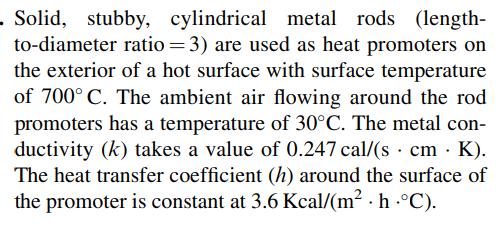Answered step by step
Verified Expert Solution
Question
1 Approved Answer
. Solid, stubby, cylindrical metal rods (length- to-diameter ratio=3) are used as heat promoters on the exterior of a hot surface with surface temperature


. Solid, stubby, cylindrical metal rods (length- to-diameter ratio=3) are used as heat promoters on the exterior of a hot surface with surface temperature of 700 C. The ambient air flowing around the rod promoters has a temperature of 30C. The metal con- ductivity (k) takes a value of 0.247 cal/(s cm .K). The heat transfer coefficient (h) around the surface of the promoter is constant at 3.6 Kcal/(m. h.C). (a) Analyze a single rod of 4 mm diameter and show! that the steady-state differential balance yields the following differential equation: d'T dx (2h) Rk for the case when metal temperature changes mainly in the x-direction (x is directed outward from the hot surface, and rod radius is R). (b) Find the characteristic roots for the ODE in part (a). What are the physical units of these roots? (e) Find the solution of part (a) using the conditions x = 0 (hot surface) x=L(exposed flat tip) dT (T-TA)=0; 2R= diameter T = TH. =h(T-TA), and show the temperature profile is represented by T-TA TH-TA cosh [2() ()Bi 2 tanh( 2(L/D)v/Bi) + vi 2+vBitanh(2(L/D)VB) }}= sinh where Bi=hD/k (Biot number, dimensionless; the ratio of film to metal transfer rates). (d) Use the definitions of total heat flow and find the effectiveness factor for the present promoter Omas and show that the general expression for n is 1 1 2Bi(L/D+1/4) [22 tanh|2| ((1) ( (1) I 1+;VBitanh|2| VBi 1 Bi + Bi /Bi 1 n (1 + (L/D) - Bi) (e) For small arguments, 2(L/D)Bi < 1, show that the effectiveness factor becomes approximately Hint: look at the series expansion for tanh( (f) Compute n for the present promoter.
Step by Step Solution
There are 3 Steps involved in it
Step: 1

Get Instant Access to Expert-Tailored Solutions
See step-by-step solutions with expert insights and AI powered tools for academic success
Step: 2

Step: 3

Ace Your Homework with AI
Get the answers you need in no time with our AI-driven, step-by-step assistance
Get Started


